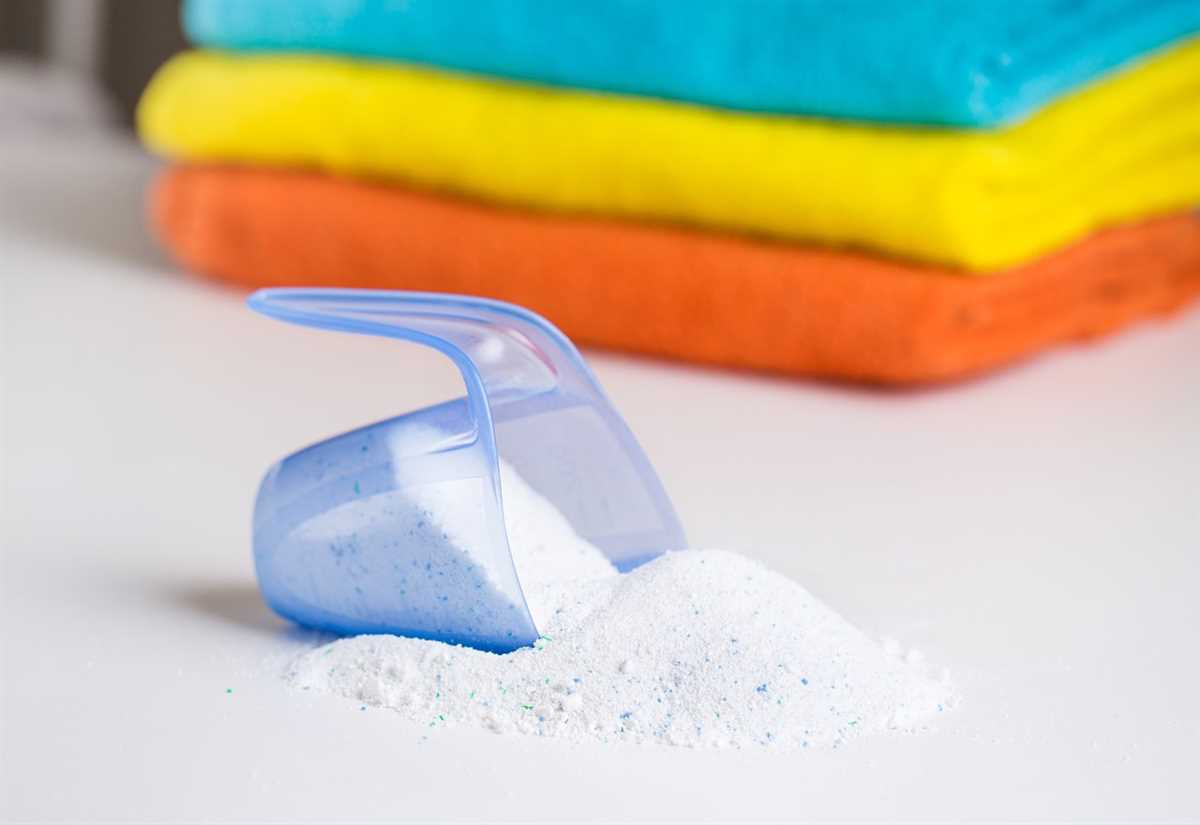




When it comes to choosing laundry detergents for colours, one of the main decisions you’ll face is whether to go for bio or non-bio options. Both types have their own benefits and considerations to keep in mind. In this article, we’ll explore the key differences between bio and non-bio detergents and provide you with the information you need to make an informed choice.
The Basics of Bio and Non-Bio Detergents
Bio detergents, also known as biological detergents, contain enzymes that are specifically designed to break down and remove organic stains, such as food, grass, and blood. These enzymes work at lower temperatures, making bio detergents especially effective for cold and quick wash cycles. On the other hand, non-bio detergents do not contain these enzymes and rely on other active agents to remove stains and dirt.
While bio detergents may provide superior stain-removing power, some individuals may have sensitive skin or allergies that can be aggravated by the enzymes found in bio detergents. Non-bio detergents are often recommended for those with sensitive skin or respiratory conditions, as they are typically fragrance-free and gentler on the skin.
Environmental Considerations
Another factor to consider when choosing between bio and non-bio detergents is the environmental impact. Bio detergents may have a higher environmental footprint due to the production and disposal of the enzymes used in their formulation. Non-bio detergents, on the other hand, may contain ingredients like phosphates, which can contribute to water pollution.
Ultimately, the choice between bio and non-bio detergents for colours depends on your specific needs and priorities. If you have tough stains and are looking for maximum stain-removing power, bio detergents may be the best choice for you. However, if you have sensitive skin or prioritize environmentally-friendly options, non-bio detergents may be a better fit. Consider your individual circumstances and make an informed decision that aligns with your values.
Differences in Ingredients and Composition
When choosing between bio and non-bio detergents for colours, it’s important to consider the differences in their ingredients and composition. These factors can have an impact on the effectiveness and safety of the detergent.
Bio Detergents

Bio detergents, also known as enzyme-based detergents, contain enzymes that help break down stains and dirt. These enzymes are derived from natural sources such as plants and microorganisms. They work by targeting specific types of stains and breaking them down into smaller molecules, making it easier for the detergent to lift them away from the fabric.
Additionally, bio detergents may also contain other natural ingredients like plant-based surfactants, which help to remove dirt and oil from the fabric. These ingredients are biodegradable and are considered more environmentally friendly compared to some synthetic surfactants found in non-bio detergents.
Non-Bio Detergents
Non-bio detergents, on the other hand, do not contain enzymes. Instead, they rely on a combination of synthetic surfactants and other chemical ingredients to remove stains and dirt from clothes. These surfactants work by reducing the surface tension between the water and the stain, allowing the detergent to penetrate and lift away the dirt.
Non-bio detergents are generally considered to be milder and less likely to cause skin irritation or allergies compared to bio detergents. This is because they do not contain enzymes or other potentially irritating ingredients. They are often recommended for individuals with sensitive skin or allergies.
However, it’s important to note that non-bio detergents may not be as effective at removing certain types of stains, particularly those caused by protein-based substances like blood or grass. In these cases, a bio detergent with enzyme-based formula may be more effective.
Conclusion
In summary, the main differences between bio and non-bio detergents for colours lie in their ingredients and composition. Bio detergents contain enzymes derived from natural sources and are effective at targeting specific types of stains. Non-bio detergents, on the other hand, rely on synthetic surfactants and are generally considered milder and less likely to cause skin irritation. Consider your individual needs and the types of stains you commonly encounter when choosing between these two options.
Impact on Fabric Quality and Color Retention
When choosing between bio and non-bio detergents for your colored fabrics, it’s important to consider the impacts on fabric quality and color retention. Both types of detergents have their own advantages and drawbacks in this regard.
Non-Bio Detergents
Non-bio detergents are typically milder and gentler on fabrics compared to bio detergents. They are often recommended for delicate fabrics, such as silk or wool, as they have a lower likelihood of causing damage or fading. The enzymes found in bio detergents, which are effective at breaking down stains, can sometimes be too harsh for sensitive fabrics.
Additionally, non-bio detergents are less likely to leave behind residues, which can also contribute to fabric deterioration over time. This makes them a suitable choice for fabrics that require frequent washing or have a tendency to retain detergent residues, such as sportswear or diapers.
Bio Detergents
Bio detergents, on the other hand, are known for their powerful stain-removing capabilities. The enzymes present in bio detergents help to break down tough stains and dirt particles effectively, resulting in cleaner and brighter fabrics. This can be especially beneficial for heavily soiled or stained fabrics, such as children’s play clothes or kitchen towels.
However, the enzymes in bio detergents can also have a detrimental effect on fabric quality and color retention. These enzymes can be abrasive and can cause color fading or damage to certain fabrics, particularly if used incorrectly or in excessive amounts. It’s important to carefully follow the manufacturer’s instructions and consider the fabric’s specific care requirements when using bio detergents.
Considerations
It’s essential to consider the specific needs of your colored fabrics when choosing between bio and non-bio detergents. For delicate or sensitive fabrics, non-bio detergents may be the safer choice to preserve fabric quality and color vibrancy. On the other hand, if you have heavily soiled fabrics or stains that need extra attention, bio detergents can provide effective cleaning results.
Always check the garment care labels and follow the manufacturer’s instructions for both the fabric and the detergent to ensure the best possible outcome. Additionally, conducting small patch tests on inconspicuous areas of the fabric can help you determine whether a detergent is suitable for a particular material.
Remember, maintaining the quality and color of your fabrics is important, so choosing the right detergent based on your specific fabric needs is crucial for long-lasting and vibrant colors.
Considerations for Sensitive Skin and Allergies
If you have sensitive skin or allergies, it’s essential to consider the impact of using bio or non-bio products for your colored clothing. Here are some factors to keep in mind:
Allergies
- Non-bio detergents: Some non-bio detergents may contain ingredients that can trigger allergic reactions in sensitive individuals. It’s important to read the ingredients list carefully and avoid any known allergens.
- Bio detergents: Bio detergents may also contain enzymes, fragrance, or other additives that can cause allergies in some people. If you have known allergies, it’s best to opt for fragrance-free and hypoallergenic bio detergents.
Skin Sensitivity

For those with sensitive skin, the following considerations are crucial:
- Fabric Irritants: Colored clothing is often made from a variety of materials, some of which may cause skin irritation. Be aware of the fabrics used in your garments and choose detergents that are gentle on those materials.
- Chemical Sensitivity: Both bio and non-bio detergents contain chemicals that can cause skin irritation. Consider using detergents that are specifically formulated for sensitive skin or those that are labeled as gentle and hypoallergenic.
Recommendations

To minimize the risk of skin reactions and allergies when washing colored clothing, consider the following suggestions:
- Look for detergents that are labeled as suitable for sensitive skin or hypoallergenic.
- Choose fragranced or fragrance-free detergents based on your own sensitivities.
- Read the ingredients list and avoid known allergens.
- Perform a patch test before using a new detergent on your colored clothing.
- Consider using natural or homemade laundry detergents that have minimal or no added chemicals.
Remember, everyone’s skin is different, so it may take some trial and error to find the right detergent that works well for your colored clothing without causing any skin reactions or allergies.
Environmental Impact and Sustainability
The choice between bio and non-bio colors can have a significant impact on the environment and overall sustainability. Here are some key factors to consider:
Biodegradability
- Biodegradable colors are made from natural and organic materials that break down over time, minimizing their impact on the environment. These colors decompose into harmless substances, reducing landfill waste.
- In contrast, non-bio colors are often composed of synthetic chemicals that do not readily biodegrade. These colors can persist in the environment for long periods, leading to potential pollution and harmful effects on ecosystems.
Resource Extraction
- The production of bio colors typically requires fewer resources compared to non-bio colors. Natural pigments can often be sourced from renewable materials like plants, reducing the need for extensive extraction processes.
- Non-bio colors, on the other hand, may rely on the extraction of finite resources such as petroleum or natural gas for their production. This extraction can have significant environmental impacts, including habitat destruction and greenhouse gas emissions.
Toxicity and Health Risks
- Some non-bio colors may contain toxic substances like heavy metals or volatile organic compounds (VOCs). These can pose risks to human health and the environment, especially during production, use, and disposal.
- Biodegradable colors, being derived from natural materials, are generally considered safer and have lower toxicity levels. However, it’s important to note that some natural pigments may still cause allergic reactions or other adverse effects in certain individuals.
Sustainability Certifications
- Various sustainability certifications and labels are available for both bio and non-bio colors. These certifications provide assurance that the products meet specific environmental and ethical standards.
- When choosing between bio and non-bio colors, look for certifications such as organic, eco-friendly, or carbon-neutral. These certifications indicate that the colors have been produced using environmentally sustainable practices.
Ultimately, the choice between bio and non-bio colors should be based on a thorough analysis of their environmental impact and sustainability factors. Considering factors like biodegradability, resource extraction, toxicity, and sustainability certifications can help make an informed decision that aligns with your environmental values.
Cost Analysis and Consumer Preferences
1. Cost Analysis
When choosing between bio and non-bio colors, cost is a significant factor that consumers need to consider. While bio colors may be seen as more environmentally friendly, they tend to be more expensive than non-bio colors. The production process for bio colors requires special ingredients and techniques, which contribute to the higher cost. Non-bio colors, on the other hand, are more readily available and often cheaper due to their conventional production methods.
Consumers should weigh the difference in cost between bio and non-bio colors and decide whether the potential environmental benefits of bio colors outweigh the higher price.
2. Consumer Preferences
Consumer preferences play a crucial role in the decision-making process when it comes to choosing between bio and non-bio colors.
- Environmental consciousness: Some consumers prioritize environmentally friendly options and prefer bio colors because they are made from natural ingredients and are biodegradable. They consider the impact their choices have on the environment and are willing to pay a premium for bio colors.
- Concern for health: Others may choose bio colors due to concerns about potential health risks associated with synthetic ingredients found in non-bio colors. They prefer to use products that are free from harmful chemicals and are perceived as safer for themselves and their families.
- Cost-consciousness: However, many consumers prioritize affordability and may choose non-bio colors due to their lower price point. They may not be as concerned about the environmental or health aspects and opt for the more economical option.
It’s essential for companies to understand consumer preferences and cater to different market segments by offering a range of bio and non-bio color options at various price points.
FAQ
What are bio and non-bio colours?
Bio colours are made from naturally derived ingredients, while non-bio colours are made from synthetic chemicals that are not derived from natural sources.
Are bio colours safe to use on the skin?
Yes, bio colours are generally considered safe to use on the skin. They are made from natural ingredients and do not contain harmful chemicals. However, it is always recommended to test the colour on a small patch of skin before applying it to a larger area, especially for those with sensitive skin or allergies.
What are the benefits of using bio colours?
Using bio colours has several benefits. They are less likely to cause skin irritation or allergic reactions compared to non-bio colours. Bio colours are also more environmentally friendly, as they are made from natural ingredients and do not contribute to pollution or contain harmful chemicals that can harm the ecosystem.
Can non-bio colours have any negative effects on the skin?
Non-bio colours can potentially cause skin irritation, especially for those with sensitive skin or allergies. They may also contain harsh chemicals that can dry out the skin or cause long-term damage. It is important to read the ingredients list carefully and choose non-bio colours from reputable manufacturers to minimize the risk of negative effects on the skin.
Should I choose bio or non-bio colours for my child?
It is generally recommended to choose bio colours for children, as they are less likely to cause skin irritation or allergic reactions. Children’s skin is often more sensitive, and using non-bio colours can increase the risk of negative effects. However, if your child has previously had no problems with non-bio colours and does not have any known allergies, non-bio colours may also be safe to use.
What is the difference between bio and non-bio colours?
Bio colours are made from natural and organic ingredients, while non-bio colours are made from synthetic chemicals. Bio colours are considered to be more eco-friendly and safer for both the environment and human health.
Are bio colours more expensive than non-bio colours?
In general, bio colours might be slightly more expensive than non-bio colours. This is because the production of bio colours often involves using higher quality and more expensive natural ingredients. However, the price difference is usually not significant and can vary depending on the specific brand and product.













